This first table shows the XE 240’s Watts/10 Delta Temp numbers in a quick glance chart format.

Using this data we can effectively show percentage gains/losses relative to a reference point. It’s an interesting way to show gains/losses while changing a variable.
So, let’s focus on 1300 RPM as our reference and see how much gain or loss in performance we get by changing fan speed.

The larger gap in performance between 750 and 1300 rpm indicates that the XE240 is better suited to medium and high speed fans. This was the case with the 360mm version also where it placed 1st in those 2 categories. That is not to say the XE’s are slouches with low speed fans though, as the 360mm placed second (of 28) in this category. This is further evidence that the XE 240 is is an excellent performer at all fan speeds.
So from the data above we have a good idea of how the XE 240 radiator performs relative to itself in Push Only and Push/Pull at various fan speed, but there is a large selection of 240mm radiator models to choose from, released from numerous manufacturers.
As we have another 240mm rad with testing complete, let’s do just that by putting the XE 240 head to head with HWLabs’ SR2 240 MP. It may not be the fairest comparison ever done because while they are both 60mm thick, the EK XE has a much denser core which should equate to much better thermal results.
Push Only Data vs Competition
Let’s focus on the Push Only results for now and come back to the Push/Pull data later.
Let’s start with 750 RPM and see how it compares to the competition:
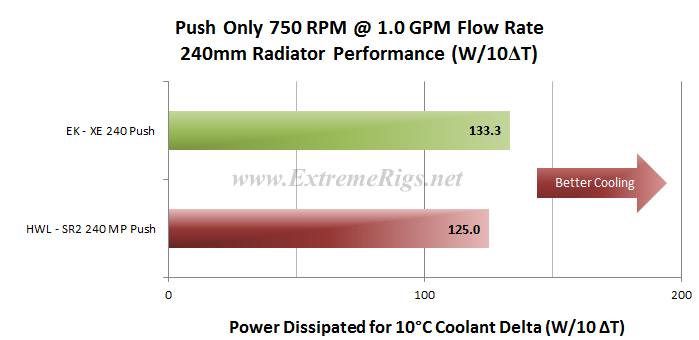
Here the XE outperforms the SR2 which is optimized for low speed fans due to its very low 9 FPI. This is a fantastic result for the XE 240.
Now let’s look at 1300 rpm:
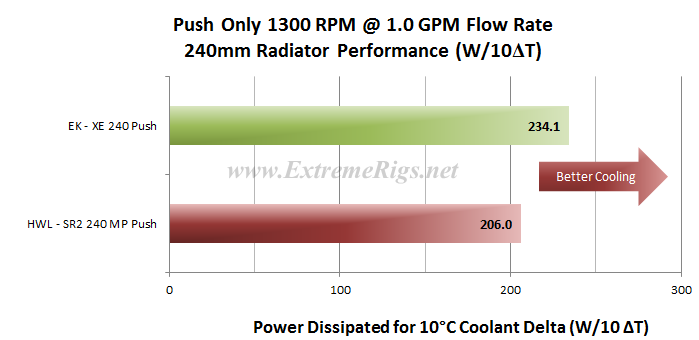
At 1300 rpm the XE performs better again, now 13% ahead of the competition.
The XE 240 took 1st place at all the Push Only fan speeds. It has a higher fin count advantage and we expect more of the same dominance in the Push/Pull comparisons.
Push/Pull Data vs. Competition
Let’s now look at the Push/Pull results and see how the XE 240 compares.
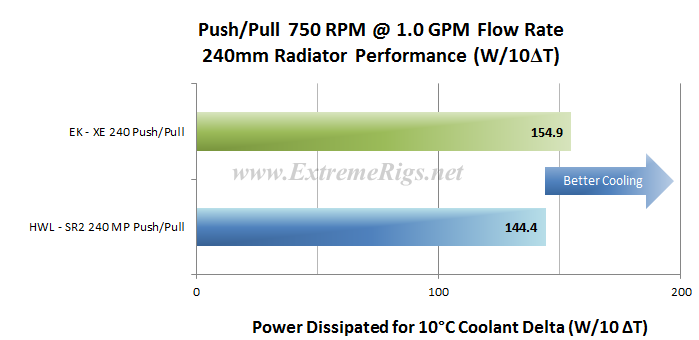 The XE takes first place ~7% ahead of the competitor, and virtually mirrors the Push Only result in terms of the percentage it is ahead.
The XE takes first place ~7% ahead of the competitor, and virtually mirrors the Push Only result in terms of the percentage it is ahead.
Let’s move to 1300 rpm:
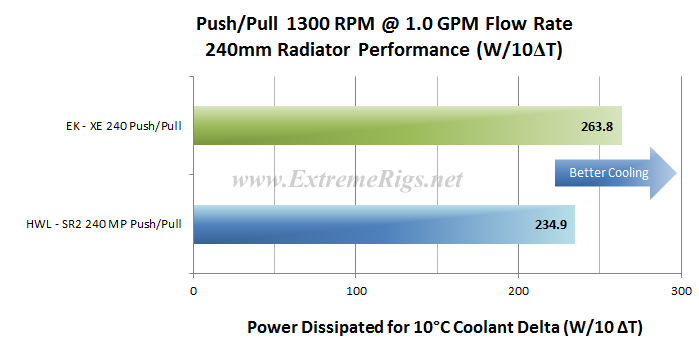
In the 1300 rpm Push/Pull category the XE 240 took the win again, now 11% clear of the SR2.
Now 1850RPM:
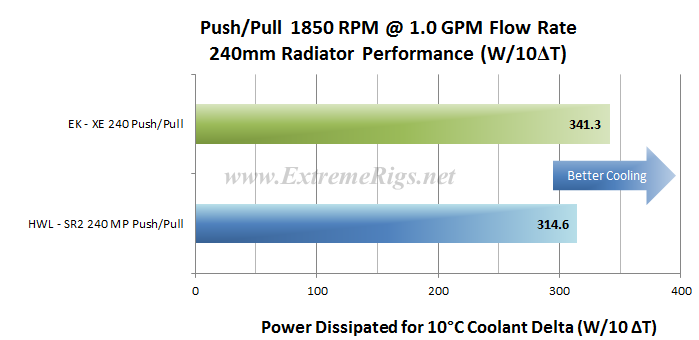
Surprisingly the SR2 regains some ground on the XE 240 here, but the XE was still ~8% ahead and is clearly the stronger performer.
Let’s also combine the Push Only and Push/Pull results at our 1.0 GPM flow rate into one plot for each fan speed tested.
Again the 750 rpm first:
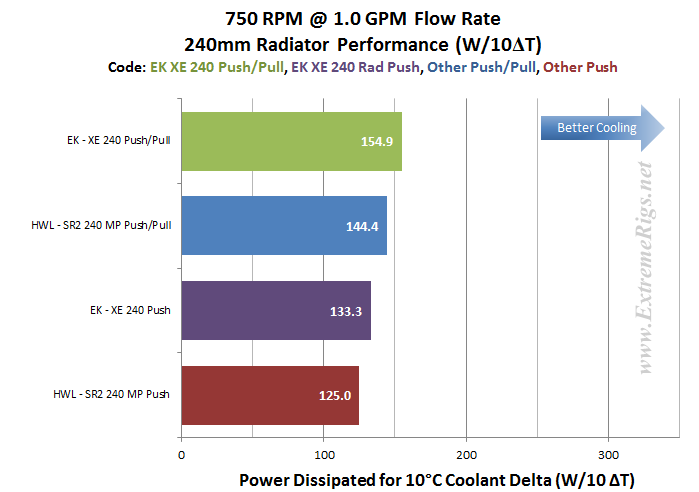 Nothing looks out of place here given the data we have reviewed already.
Nothing looks out of place here given the data we have reviewed already.
At 1300 rpm everything looks in order given again. Of interest though is how close the XE 240 rad in Push Only came to beating the SR2 in Push/Pull.
It was exactly the same with the 1850 combined.
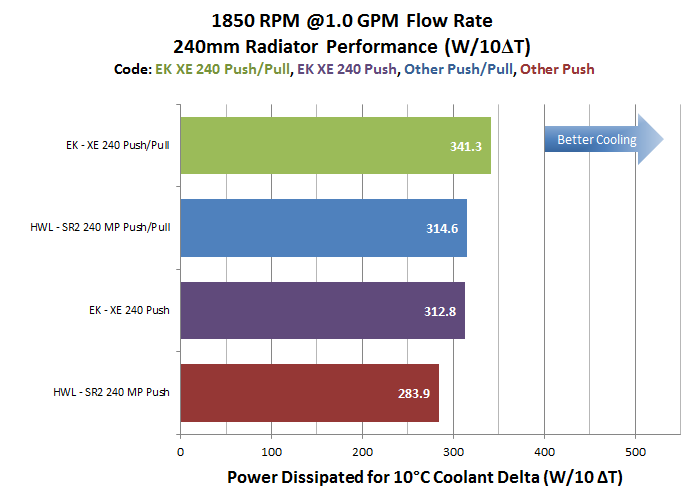
From all of test results we created “Average Performance Factor” charts for both Push and Push/Pull and then a combined plot called the “Master Performance Factor”. The radiator with the best cooling ability (W/10ΔT) at each rpm was awarded a score of 100, and each other radiators W/10ΔT result was scored as percentage of the top performer.
This way of looking at the comparison takes away any advantages that a radiator may have at higher or lower fan speeds and looks at an overall average. While this appears fair it does tend to favor those radiators that are all-rounders and those radiators which do very well at high RPM. Most users should be more focused on their specific use case.
Here is the XE 240’s percentage scores at each data point that thermal tests were conducted at with the addition of the XE’s Push Only results relative to the Best performing Push/Pull results (which was it’s own):
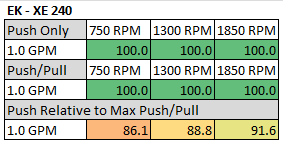 The XE 240 obviously dominated the thermal performance comparisons, taking first place in all 6 data points that we tested at.
The XE 240 obviously dominated the thermal performance comparisons, taking first place in all 6 data points that we tested at.
The percentage numbers in the table above offer another way of looking at the XE 240’s results comparatively and how it performed, but for our scoring system we need a way to reduce the categories while retaining the data. To do this we average the results for each fan assembly type giving us Averaged Performance Factors for Push Only, Push/Pull and finally an average of everything in the Master Averaged Performance Factor.
Can anyone guess what will be the average of 3 x 100% scores?
Firstly – the Push Only APF:
Push/Pull APF:
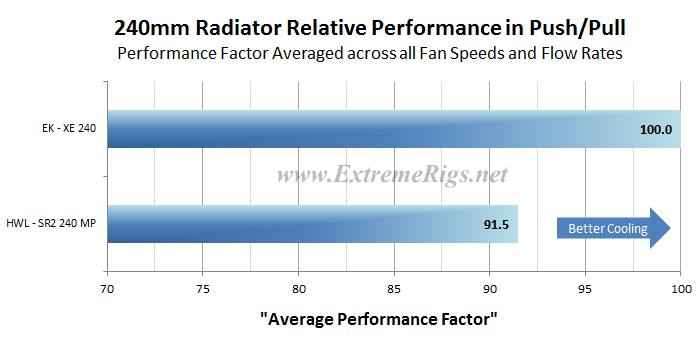
Finally we created the Master Performance Factor which is calculated from the averaged results of all the Push Only and Push/Pull thermal tests, at all fan speeds.
Before we conclude, let’s take a look at the XE 240 and XE 360 comparisons and see how much of a difference up-sizing might make for the heat dissipation levels. We did test the 360mm version at 3 flow rates, but only the 1.0 GPM data has been used in the charts below.
The difference is not as great as one might expect, this is partly due to the way that the 240mm was tested, and will be explained that in more detail below.
Firstly though, the same data presented differently for the lovers of curves:
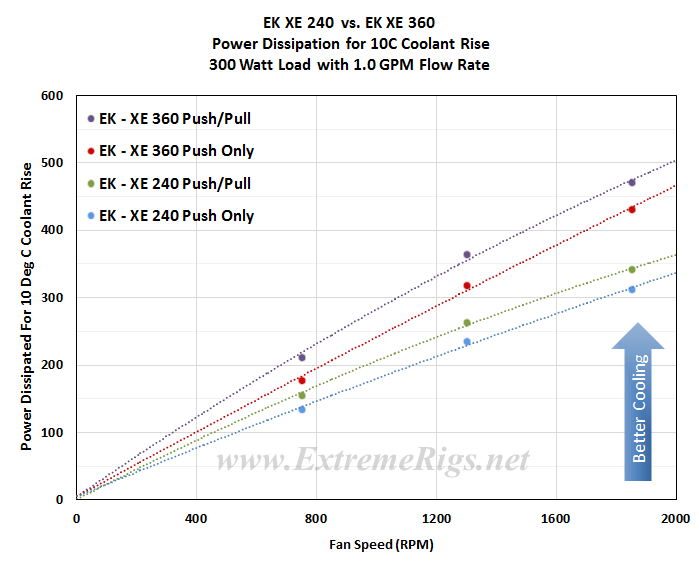 Having done then 360mm testing previously we had to decide how we were going to set up for testing other sizes. There were two practical options, both of which had advantages and disadvantages and none of the ER staff could ever really agree on which was the better option.
Having done then 360mm testing previously we had to decide how we were going to set up for testing other sizes. There were two practical options, both of which had advantages and disadvantages and none of the ER staff could ever really agree on which was the better option.
The first option was to run a power load proportional to that which was run for the 360mm rads, which was 300 Watts. For 240mm rads that would be 200 watts, being 66% of the surface area of a 360mm rad. This would show us the scalability of the different size of each model rad quite well, but the comparison results would be likely to end up in the exact same order as the 360mm Round Up and therefore maybe not the best comparison for readers who may be looking to purchase one or the other size of a particular radiator.
Another problem with this option is that the heater used for testing is 300 Watt, so for larger rads such as 420mm, 480mm and 560mm another heater would need to be incorporated in the test chamber loop, which would be a big change to they system in itself that would likely then render the test system useless for comparisons to older test data (any system change makes things no longer apples to apples – and yes the system is that sensitive).
The second option, which is what we have decided to use, was to run with 300 Watts on the 240 radiators. This mirrors the fact that we keep the heatload constant even when changing fan RPM. This gives a good comparison between different sizes of the same rad, as we are simulating a set load in a similar way to which a running system might. The downside to this test method is that we may run into temperature issues. On the smaller 120mm and 140mm rads 300 Watts is just going to be too much for them to dissipate with safe and acceptable coolant temps, so we may end up not getting full sets of data, in particular the Push Only 750 RPM data point would be almost certain to have coolant temps which are too high to test at. On the other end of the scale for any 480mm or 560mm rads, the cooling potential is likely to be very high resulting in very lower Delta Temps which could lead to data having to be discarded, particularly for the Push/Pull 1850 RPM data point.
There is no right or wrong choice, the results would just be slightly different due to Delta Temps being different between the two test options. In the end we are happy with the option which we chose as we believe it offers the reader a better comparison between different size radiators as they have all been tested under the same conditions. However as a reader you should be aware that W/10DT numbers are not calculated here with a delta of 10C so radiators with higher temperature deltas are operating more efficiently and will score higher than perhaps they should for a true scientific accurate test of heat dissipation for a 10C delta.
Next up – Summary!







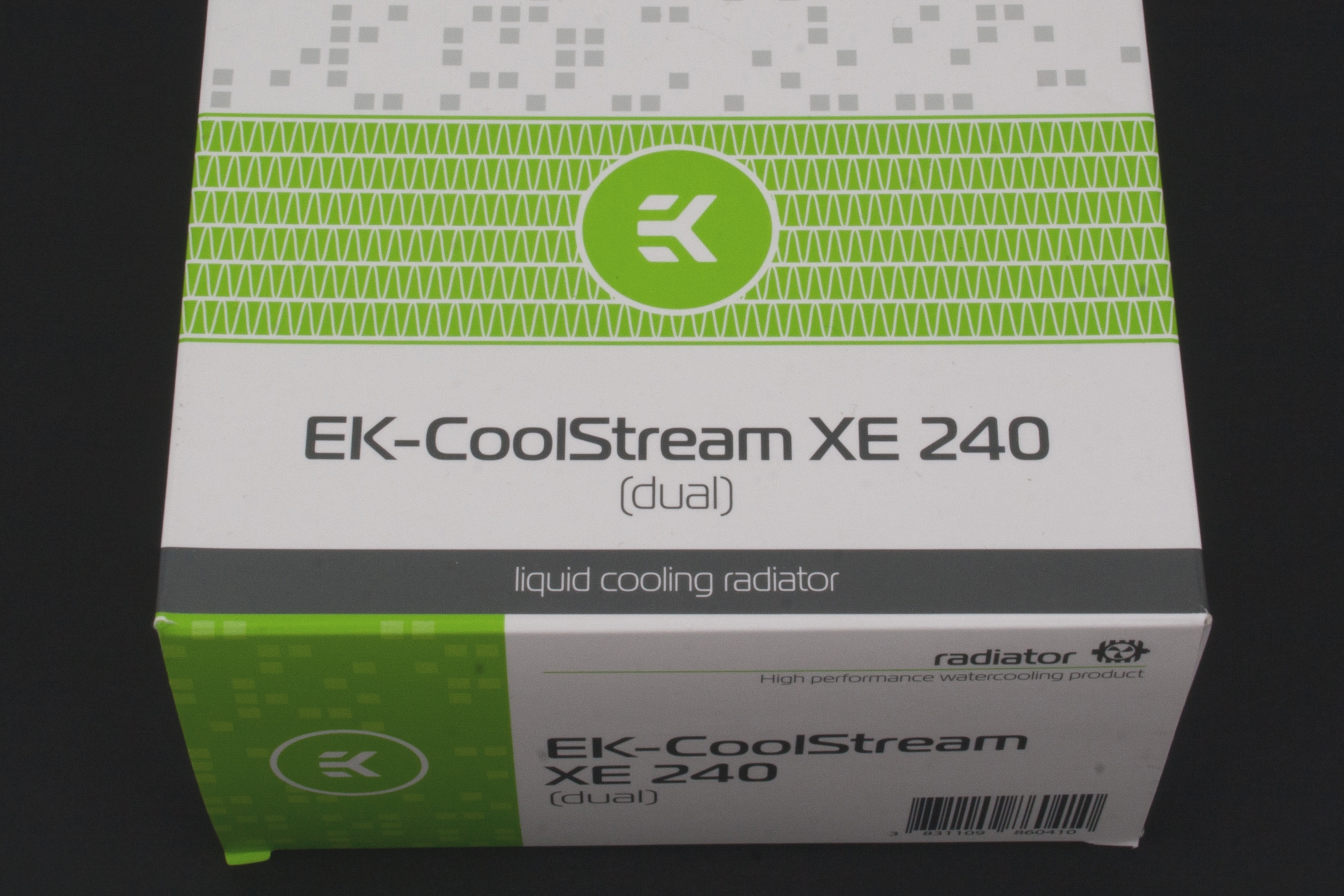
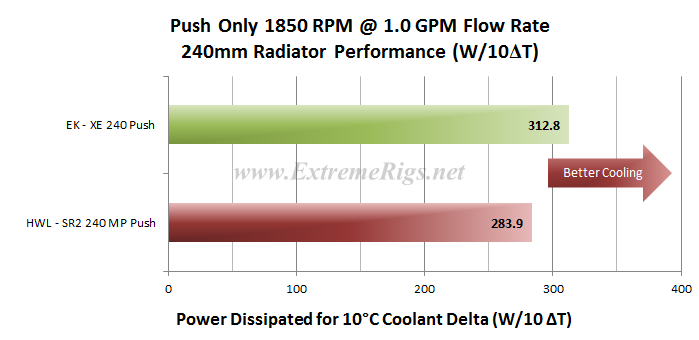
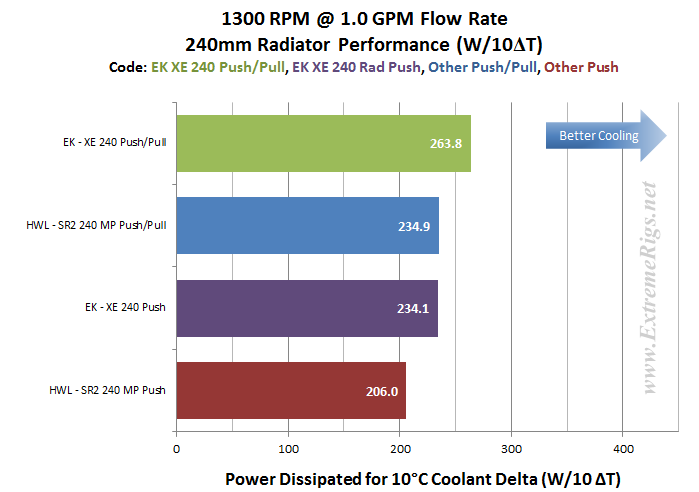
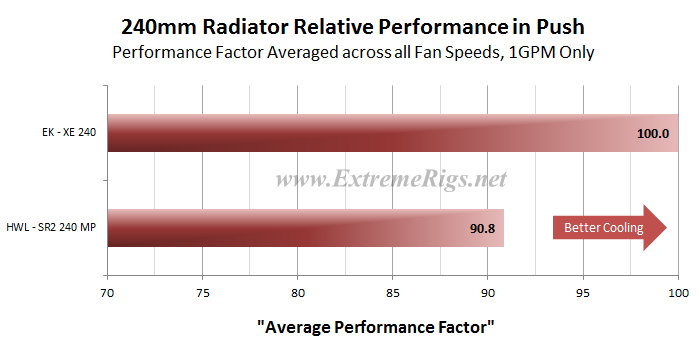
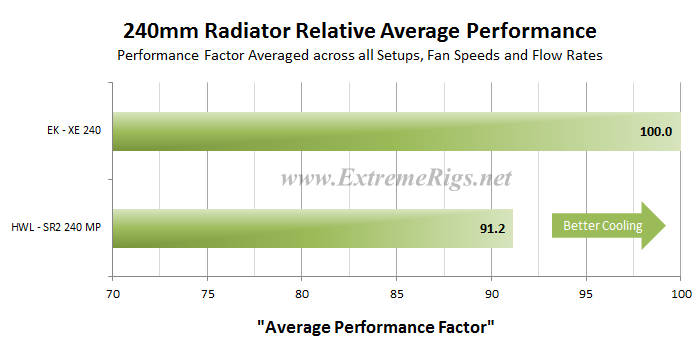
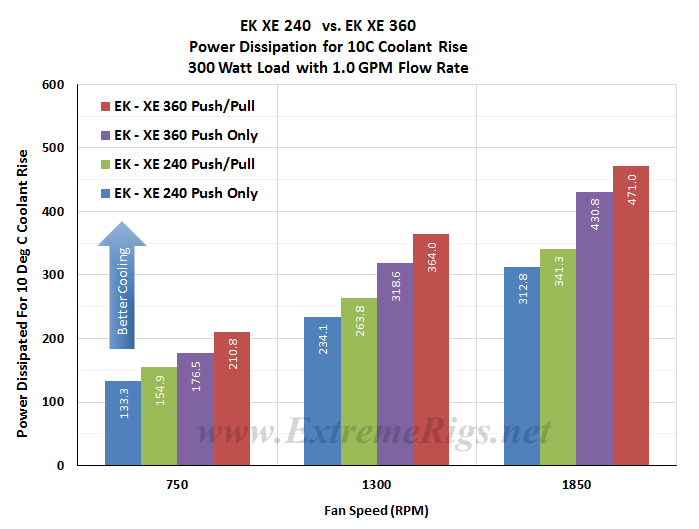




No reviewer out there has a summary of dual 280mm radiators!
You seem to be the only reviewer (great job BTW) who has some statistical data on the EK-CoolStream CE 280mm
Have been searching for comparative data against the nexXxos UT60 280mm.
Hopefully something turns up soon!
Thanks.
It’s been a while coming admittedly, but the first of our 280mm radiator reviews will be published tomorrow.
Comments are closed.